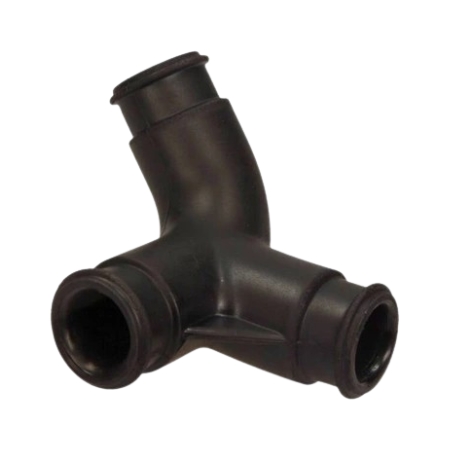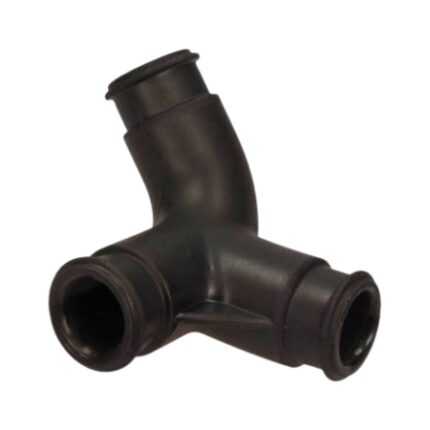Get Vw Passat Breather Vent Hose 06B103221P in Kenya
The breather vent hose is a crucial component in a vehicle’s engine and emissions system, responsible for managing and directing air and vapor flow within the engine compartment. It plays an essential role in maintaining engine performance, reducing emissions, and ensuring efficient operation. This comprehensive overview delves into the function, importance, types, common issues, maintenance, and consequences of a malfunctioning breather vent hose.
Function of the Breather Vent Hose
The breather vent hose serves several key functions within the engine system:
- Ventilation of Engine Vapors: The primary function of the breather vent hose is to provide a pathway for engine vapors and gases to escape from the engine’s crankcase. These vapors, which include blow-by gases (combustion gases that leak past the piston rings) and other engine fumes, are routed through the breather system to be managed properly.
- Maintaining Crankcase Pressure: The breather vent hose helps regulate crankcase pressure by allowing excess gases and vapors to be expelled from the engine. This prevents excessive pressure buildup, which could lead to oil leaks, seal damage, or engine performance issues.
- Reducing Emissions: By directing crankcase gases and vapors through the breather system, the hose helps to minimize the release of these substances into the atmosphere. This contributes to the vehicle’s emissions control system, ensuring compliance with environmental regulations and reducing the impact on air quality.
- Enhancing Engine Efficiency: Proper ventilation through the breather vent hose helps maintain optimal engine efficiency. It ensures that the crankcase remains at a balanced pressure, which contributes to smooth engine operation and better overall performance.
- Preventing Oil Contamination: The breather vent hose helps prevent the buildup of contaminants, such as moisture and unburned fuel, in the engine oil. By directing vapors and gases away from the crankcase, it helps maintain the quality of the engine oil and prolongs its service life.
Importance of the Breather Vent Hose
The breather vent hose is critical for several reasons:
- Engine Health: Proper ventilation of crankcase gases is essential for maintaining engine health. By preventing excessive pressure and vapor buildup, the breather vent hose helps protect engine components from damage and wear.
- Emissions Control: The breather vent hose is part of the vehicle’s emissions control system. By managing crankcase vapors and gases, it helps reduce harmful emissions and ensures the vehicle complies with environmental standards.
- Performance and Efficiency: Efficient ventilation through the breather vent hose contributes to better engine performance and fuel efficiency. It helps maintain optimal operating conditions for the engine and prevents issues such as poor acceleration or reduced power.
- Preventing Oil Issues: By directing vapors away from the crankcase, the breather vent hose helps prevent oil contamination and ensures proper lubrication of engine components. This extends the life of the engine oil and reduces the risk of engine damage.
Types of Breather Vent Hoses
There are several types of breather vent hoses, each designed to fit specific engine configurations and applications:
- Flexible Rubber Hoses:
- Description: Flexible rubber hoses are commonly used in many vehicles. They are made from durable rubber materials that can withstand the heat and pressure of engine operation.
- Function: These hoses provide a flexible connection between engine components, allowing for movement and vibration while maintaining a secure seal.
- Plastic Breather Tubes:
- Description: Plastic breather tubes are lightweight and often used in modern vehicles. They are made from high-quality plastics designed to handle engine temperatures and pressures.
- Function: Plastic tubes offer a rigid and stable connection, reducing the risk of hose collapse or deformation under engine conditions.
- Silicone Hoses:
- Description: Silicone hoses are high-performance hoses made from silicone rubber. They are known for their durability and resistance to extreme temperatures.
- Function: These hoses are used in high-performance or aftermarket applications where superior resistance to heat and chemicals is required.
- Integrated Breather Assemblies:
- Description: Some engines use integrated breather assemblies that combine the breather vent hose with other components, such as filters or separators.
- Function: These assemblies simplify the breather system design and provide a compact solution for managing crankcase gases and vapors.
Common Issues with Breather Vent Hoses
Breather vent hoses can develop issues over time due to wear, contamination, or environmental factors. Common problems include:
- Cracking or Splitting: Exposure to high temperatures and engine vibrations can cause rubber or plastic hoses to crack or split. This can lead to leaks and reduced effectiveness in managing crankcase gases.
- Clogging: The breather vent hose can become clogged with debris, sludge, or contaminants. Clogging can restrict the flow of gases and affect engine performance.
- Leaks: Leaks in the breather vent hose can occur due to damage, wear, or poor connections. Leaking hoses can lead to reduced engine efficiency and increased emissions.
- Collapsed Hoses: Some hoses may collapse under vacuum or pressure if they are not properly reinforced. A collapsed hose can restrict airflow and affect the engine’s performance.
- Disconnected Hoses: Improper installation or maintenance can lead to disconnections in the breather vent hose. Disconnected hoses can cause vacuum leaks and impact engine operation.
Signs of a Failing Breather Vent Hose
Recognizing the signs of a failing breather vent hose is essential for timely maintenance and avoiding engine issues. Common symptoms include:
- Engine Overheating: A faulty breather vent hose can lead to improper ventilation, causing the engine to overheat. Overheating can result in engine damage and reduced performance.
- Poor Engine Performance: Issues with the breather vent hose can cause poor acceleration, rough idling, or reduced power output. These symptoms may indicate a problem with the hose or its connections.
- Increased Oil Consumption: If the breather vent hose is not functioning correctly, it can lead to increased oil consumption and oil leaks. Check for signs of oil around the hose or engine components.
- Check Engine Light: The check engine light may illuminate if the engine control unit detects issues related to the breather system. This may include trouble codes related to the hose or ventilation system.
- Unusual Engine Smells: A damaged or leaking breather vent hose can cause unusual smells, such as burning oil or coolant odors. These smells may indicate a problem with the hose or other engine components.
Maintenance and Replacement of the Breather Vent Hose
Proper maintenance and timely replacement of the breather vent hose are essential for ensuring the engine operates efficiently. Key practices include:
- Regular Inspection: Periodically inspect the breather vent hose for signs of wear, damage, or leaks. Check for cracks, splits, or loose connections.
- Clean or Replace the Hose: If the hose becomes clogged or damaged, clean or replace it as needed. Follow the vehicle manufacturer’s recommendations for replacement parts.
- Check for Leaks: Monitor the area around the breather vent hose for leaks. Address any leaks promptly to prevent engine issues and maintain proper ventilation.
- Ensure Proper Installation: When installing a new breather vent hose, ensure that it is properly connected and aligned. Secure all clamps and fittings to prevent disconnections or leaks.
- Maintain the Breather System: Regularly check and maintain the entire breather system, including filters, separators, and other components. Follow the vehicle manufacturer’s maintenance schedule for breather system checks.
Consequences of a Malfunctioning Breather Vent Hose
A malfunctioning breather vent hose can have several negative consequences, including:
- Engine Overheating: Poor ventilation due to a faulty hose can cause the engine to overheat. Overheating can lead to severe engine damage and costly repairs.
- Reduced Performance: A failing breather vent hose can affect engine performance, including reduced acceleration, rough idling, and decreased power output. This can impact the overall driving experience.
- Increased Emissions: Ineffective ventilation can lead to increased emissions and potential failure of emissions tests. This can contribute to environmental pollution and regulatory non-compliance.
- Oil Contamination: A malfunctioning breather vent hose can lead to oil contamination, reducing the quality of the engine oil and increasing the risk of engine damage.
- Costly Repairs: Ignoring issues with the breather vent hose can lead to more severe engine problems and costly repairs. Timely maintenance and replacement can prevent these expenses and ensure reliable engine operation.
Follow us on Facebook for more parts.




